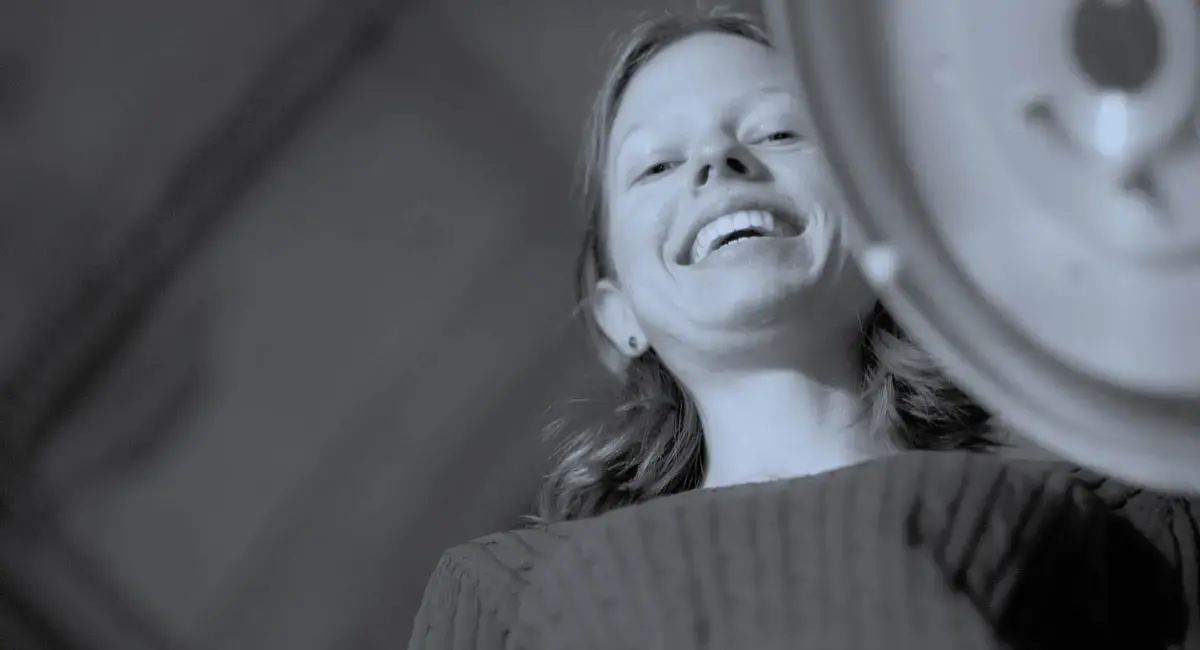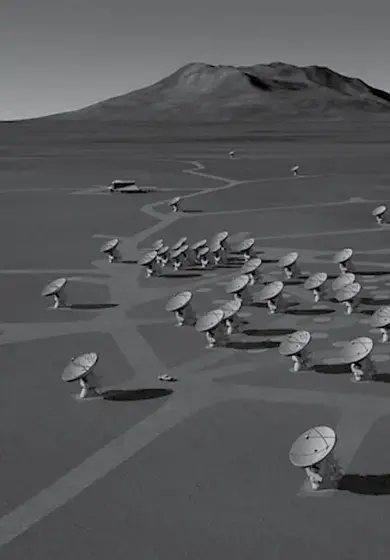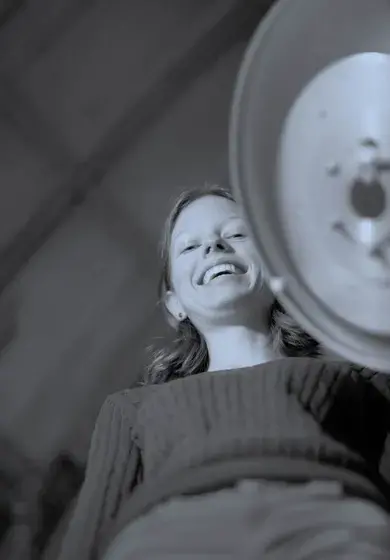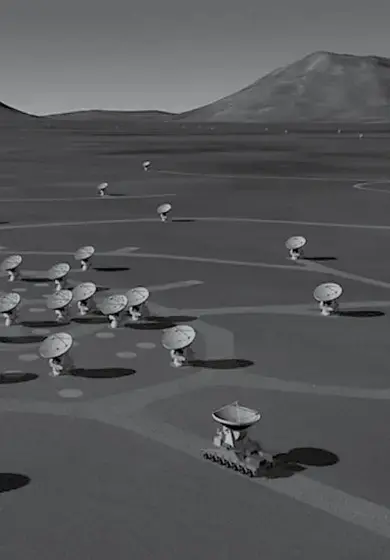Finding Focus

How one astronomy student has used Field Work Term to amass more experience
than most graduate students.
Rebecca Nakaba has already amassed more work experience than most graduate students in astronomy. She has helped NASA scientists refine an experiment to fix repeatability problems. She has written a computer program to help astronomers studying dim galaxies separate giant stars from dwarf stars. She modeled the mechanics of a light collimator for scientists at Boston University, designed a website for an engineering competition, built an irrigation system for a farm in the south of France, researched and published articles for a travel website,presented at two scientific conferences, and now she’s looking for stars—to be more precise, she’s looking at star formation rates in nearby galaxies.
For her first FWT, Rebecca wanted to stay close to home. At the time she also thought she wanted to be a travel writer, so she secured a job with Atlas Obscura. It was a good experience—one that taught her a lot about herself. “My first FWT was good for my personal growth. I realized that something can influence my identity without defining it. So for me that meant coming to the realization that even though I like reading travel writing, I’m not a travel writer.”
During her sophomore year at Bennington, Rebecca wanted to travel to Europe. So she worked on an olive farm in exchange for room and board. She farmed, designed and built an irrigation system, installed a sink, and adjusted her “overly romanticized notion of manual labor.”
When Rebecca came back to campus, between her FWT experiences and the Plan Process, she re-discovered her passion for science, specifically astronomy—something she didn’t expect. “I was getting really involved in astronomy and my professor recommended that I get more research experience in the field, so I started to look for opportunities supported by the National Science Foundation.” She found one. It was a Research Experience for Undergraduates (REU) grant, a program that funds internships for promising undergraduate scientists.
I loved that something with my fingerprints on it could be sent into space—but it wasn’t until working at the Photonics Center that I realized what I’m interested in is more human than technical. I love going after something that you know exists but can’t always see.
That summer she went to work for an astronomer at Haverford College, where Rebecca and another undergraduate wrote a program that would help identify dwarf stars and giant stars in dim galaxies around the Milky Way. At the end of the ten-week internship she presented her work at a conference along with several other students.
“After I presented a scientist approached me to ask if I had a mentor. I didn’t. And that’s when I realized that was what was so different about my experience compared to the other students presenting—I was shaping my experience. I researched the grant programs. I found internships and jobs. The other students had mentors who were shaping their work.” It sounds arduous, Rebecca says, but it was work that she wouldn’t trade. “Because I have done this work, I know how to do it. And I’m not influenced by someone else’s idea of what I should be doing. I am driving my focus—and that is important to me.”
Her next experience was at Boston University working on a NASA-funded cube satellite project for the NANO Satellite competition. Rebecca spent seven weeks shadowing electrical and mechanical engineers. She built a website. She redesigned a light collimator using a CAD 3D modeling program, SolidWorks—something she learned to do literally on the job.
“I loved that something with my fingerprints on it could be sent into space—but it wasn’t until working at BU that I realized what I’m interested in is more human than technical. I love going after something that you know exists but can’t always see.” Knowing this, Rebecca headed to NASA’s SETI institute winning another NSF grant.
When she arrived, scientists were experimenting with rocks—putting them under stress as a way to test whether or not they experienced electrical activity, which could pave the way for scientists to forecast earthquakes earlier. She was also researching if the rocks oxidize the surrounding water, a process that could be a contributor to the mass amounts of oxygen we have today and might point to the origins of life as we know it. But there was a problem. The experiment wasn’t repeatable. “My job was to figure out what was wonky.” After studying the experiment and looking closely at all of the parts, she found that the materials were causing atoms to tunnel, creating background noise. By replacing the materials with higher density plastic and steel rather than aluminum, they were able to cleanly repeat the experiment.
The scientists were impressed, really impressed. In fact if she goes to graduate school in California they would fund a position for her to continue to research with them. Dream job? She laughs. “Yeah, I guess it’s a dream job. I loved working there. But a real dream would be to repeat my Bennington experience out in the world.”

Rebecca Nakaba
Employment History
Jun 2012–Aug 2012
SETI Institute/NASA Ames Research Center
Reu research intern
- Worked closely with researchers at the SETI Institute and at NASA Ames Research Center on a planetary geology project. My task was to deduce why the team was getting strange electrical signals from rocks being put under high pressure loads, and to fix the problem. The research is being used for early earthquake warning systems, and has implications for early life formation on Earth. The results were presented at the 2012 AGU conference.
- Gained experience operating a 60-ton hydraulic press, soldering and machining, designing tests, and analyzing and interpreting data taken on a picoammeter.
- Wrote a paper on my involvement in the project, and on our findings. Presented at SETI Conference and Bennington College Science Workshop.
Jan 2012–Feb 2012
Boston University College of Engineering, Photonics Center
Systems engineering intern
- Worked with principal investigator Professor Ted Fritz on the development of BUSAT, a student-made satellite being built as part of the two-year University Nanosat-7 Program competition.
- Synthesized and presented information regarding the intentions and design of BUSAT on the BUSAT website using website program Drupal (www.busat.org).
- Used SolidWorks to design a collimator (based off of NASA’s OGO-6 collimators) for Professor Fritz that could be either 3D machined or EDM machined, the main purpose being to reduce the amount of electron contamination created by electron scatter off of surface within the collimator. Worked with BU’s Scientific Instrument Facility to make the design physically feasible.
May 2011–Jul 2011
Haverford College, Professor Beth Willman
REU research intern
- Assisted Professor Willman in her research regarding faint dwarf galaxies that orbit the Milky Way; worked in IDL programming to test photometric methods of distinguishing these galaxies from foreground faint giant stars.
- Researched other potential photometric methods of separation, as well as faint dwarf galaxies and faint giant stars themselves.
- Synthesized findings into a paper written for both Professor Willman and the KNAC: KECK conference; presented findings at KNAC: KECK conference.
Jan 2011–Feb 2011
Bennington College, Professor Doug Gobeille
Radio astronomy intern
- Sorted NRAO archives to locate sources of x-rays from quasars in the 2.0>z>2.5 gap from Professor Gobeille’s original survey several years ago.
- Compiled sources into comprehensive, clear, informative spreadsheet detailing sources in columns of RA and DEC positional coordinates in various formats (self-calculated and compared to NRAO values), and redshift.
- Through this process learned the basics of data gathering and organization.
Skills
Computer Skills
AIPS, DIFMAP, DS9, IRAF, basic IDL programming, LaTeX, SolidWorks, Processing, Arduino, experience with Mac, Windows, Linux, terminal systems, CCD experience
Other
Research experience (lab and book/journal), editing and writing experience (scientific/technical, collegiate writing/editing and professional editing for national literary anthology plain china), ability to run college physics lab, creating and running physics experiments/projects, poster writing and design for presentation of research work, strong communication skills (worked for Bennington College Office of Communications 2010-present), strong ability to focus and express ideas, experience working in both group and single research environments.



Related Courses
Group Tutorial, The Feynman Lectures
Learning and solving physics problems was done with the Feynman Lectures as the text/base of the class. Understanding the physical system qualitatively as well as quantitatively was emphasized.
SETI Institute/NASA Ames Research Center
Worked closely with researchers at the SETI Institute and at NASA Ames Research Center on a planetary geology project. My task was to deduce why the team was getting strange electrical signals from rocks being put under high pressure loads, and to fix the problem. The research is being used for early earthquake warning.
Compact Stellar Remnants
Built up a model of a star then focused on the physics of the post-main sequence stages: white dwarf, neutron star, and black hole. Problem sets involved modeling each outcome, and calculating the different physical factors associated with each.
Physics Lab Tutorial
Focused on performing and testing labs used for Bennington physics classes; helped develop new labs to better inform and test students; worked on translating common physical systems, such as a catapult, into actual device (i.e. built catapult for pumpkin chucking).
Applied Physics: Deformation of Solids
An introductory class on the mechanics and deformation of solids. Projects included building a model bridge and calculating the stress and strain on each joint in order to predict the load it could bear, and a paper and poster on a structural failure detailing why the structure failed.
Search for Life in the Universe
Closely examined methods of exoplanet detection, conditions which are necessary for life, differences in planetary systems and formation, what defines a habitable zone for a planet and why.
Descriptive Astronomy
Descriptive and mathematical overview of the field of astronomy. Covered important topics such as Newton’s Three Laws, planetary formation, stellar formation/life/death, the early universe (Big Bang theory, and resulting universe), and other general astronomy topics.
Advanced Linear Algebra
Course focused on more advanced applications and principles of linear algebra, as well as focusing on building and employing these principles from basic theorems and proofs.
Observational Techniques in Astrophysics
Covered techniques in analyzing and producing radio images of high energy sources such as quasars. The class was half lecture on the properties and functions of a quasar, and half image production. Work was done in AIPS, DIFMAP, and DS9.
Electrodynamics Tutorial
Focused on the basic principles of electrodynamics, and their relationship to physics. Coursework involved problem sets both from the book and assigned by the professor.
Orbital Dynamics
An introductory course on the physics of two-body and three-body systems. Coursework often involved both engineering and astronomy problems.
Differential Equations
Examined practical applications of differential equations in engineering, physics, and life sciences. The equations were solved both mathematically and qualitatively to ensure the physical system, and what is happening to it, makes sense.
Introduction to Applied Mathematics
Focused on specific mathematical tools required for “real world” mathematical problems. Focused on deeper understanding of the methods used (i.e. where logarithms come from, and why they work).
Physical Computing
Programmed an Arduino micro-controller using the Arduino program interface and wrote code in the program Processing for creating visuals. Used a variety of sensors including a flex sensor, photoresistor, potentiometer, and pressure sensor. For the final project I used combined sensors with three objects to create an interactive experience in which handling of the objects resulted in corresponding visuals related to stellar properties.
Science and Math Fifth Term Seminar
Focused on developing clear, relevant research questions according to students’ academic interests. Exposure to a wide variety of the sciences was emphasized, and analyses of a variety of current scientific papers was assigned to illustrate what makes a good research question, and how methodology factors in as the next step.